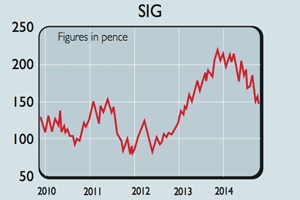
This Sheffield-based company is a typical cyclical business, whose profits rise and fall depending on what the economy is doing. It makes money by selling specialist building products from distribution sites in the UK and across Europe. It focuses on areas such as insulation, energy management, interior fit outs and roofing.
Its profits are very sensitive to changes in its sales (known as high operational gearing). That’s because all those distribution sites have fixed costs that need to be paid for, regardless of how much stuff the company is selling.
Once they have been paid for, every additional pound of sales starts making a big contribution to SIG’s (LSE: SHI) profits and its profit margin increases.
Unfortunately, the same process works in reverse, as was seen with devastating effects during the last recession. As construction activity and sales started to fall, SIG’s profits collapsed and its dividend was scrapped.
More recently, though, trading conditions have been good. During the first half of 2014, a 6.5% increase in sales fed through to an increase of more than 20% in trading profits.
Not that this has done much for SIG’s share price – it has tanked since the start of the year and is now hovering just above its 52-week low. So what’s going on?
Profits in the UK have had a big boost from the surge in housebuilding activity, while a pick up in construction in Ireland has been very helpful.
Even in Europe, where markets such as France have been difficult, profits have been growing nicely. But it seems that investors are thinking that the good times are over.
I’m not convinced that SIG’s profits are about to take a turn for the worse. Yes, there are some risks. The housing market in the UK will probably cool down as the availability of mortgages tightens up a bit, but building activity should still be pretty decent. European economies have been difficult for a while, during which time SIG has managed well.
There’s also a lot of improvements and cost-cutting going on, which should help profits. SIG is improving how it buys products and is reducing the number of branches it needs to serve customers. It is aiming to have made savings of £30m by the end of 2016.
City analysts are still forecasting strong profit growth for this year and next. On 12 times this year’s forecast earnings, falling to ten times next year, SIG’s share price does not look too frothy and could be due a bounce.
Verdict: worth a punt